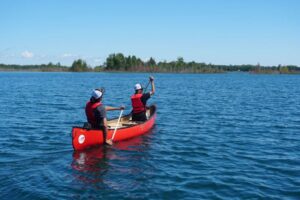Opinion: Bi-waabndamewizig Anishinabek Nation – Tourism and Economic Development

Submitted by the Anishinabek Nation Economic Development Department
Throughout our exploration into areas of economic development, we have looked at things through a variety of lenses. This month, we will further explore the development of our local and business economies with a focus on the tourism industry.
Tourism encompasses a broad spectrum of service and retail sectors and is a vital component of many economic development plans. In 2019, the last normal year for the tourism industry, Canada saw $105 billion in revenue and almost 2 million jobs stemming from the tourism sector. If we think about where we live, we can identify a few factors that make our tourism potential significant.
Starting from a national scale, Canada is well known for being a friendly and safe travel destination and is positioned well to capitalize on the ever-growing experience economy. We have a unique opportunity to offer various kinds of nature-based experiences due to our four seasons, natural spaces, and wildlife.
As we move to the provincial and local scales, the concept of “staycations” and discovering local experiences are also increasing. Our local markets are seeing increases in people who want to add value and adventure to their lifestyles more frequently and through the addition of more budget-friendly options. With the impacts of COVID-19 on travel, there is an opportunity to reach out and grab the attention of people who desperately want a vacation but have been forced to reconsider their usual practices.
Now, the First Nations perspective. Cultural-based experiences are increasingly popular; people are interested in making their trips and activities purposeful, based on a desire to learn about and gain experience in different cultures. Indigenous tourism is a phrase that has grown in popularity within the industry. Some examples of goods and services within and supporting the Indigenous tourism sector include exploring our history; retail sales of traditional products like crafts, foods, and materials; or simply land-based tours guided by an Indigenous person. These types of tourism businesses have made significant impacts on communities around the world, from concepts such as Yalanji art lessons and foraging trips in Australia, Chihuahua storytelling and hiking adventures in Mexico, or Maori experiential adventures in New Zealand.
According to Indigenous Tourism Ontario, 1-in-3 international tourists coming to Canada are interested in experiencing Indigenous culture. And, if we are attracting people with our rich culture and history, why not take the lead in determining how that is portrayed and delivered, and derive the benefit from it accordingly?
Concepts such as these have tremendous potential for increasing not only capacity in the form of revenues for operators, but also communities and businesses in the community and surrounding areas. As a business model, it is undeniably a large market and has so many options that can stand alone or foster commercial cooperation, building economies and growing skillsets throughout our regions. For example, Indigenous Tourism Ontario recently launched its food tourism strategy, FEAST: Growing Indigenous Food Tourism in Ontario, which sees food as the basis for bringing people together and sharing our stories, while supporting Indigenous entrepreneurs and developing our economies.
If we consider our vast history with food – from harvesting to hunting to preparation and preservation (and, yes, eating it) – there are so many shared stories and methods, even if the food is fundamentally different. From another perspective, by expanding the concept and having additional, yet related, opportunities available, we can attract different kinds of customers based on their initial area of interest and build on that. With that comprehensive view in mind, one event or experience can become a week-long adventure.
The key here is that an industry such as Indigenous tourism also serves to preserve and promote our communities’ respective histories, cultures, and resources. As said by Gad Saad, a renowned psychologist and business professor: “Marketing is fundamental to what makes us human. Marketing is not solely about selling chewing gum, cars, cellphones, and tourist packages. Everything in life involves the process of marketing something to someone.”
There is a strong opinion that by increasing people’s awareness of Indigenous peoples’ culture, ties to the land, and history, we can see parallel increases in the level of support for rights and heritage preservation, cooperation in development opportunities and respect of human rights. Tourism provides a perfect opportunity to meet these ends when experience becomes a form of passive education. This is where we can make a tourist a traveller who values the place, the people and the experience. Daniel J Boorstin, an American historian, author and the twelfth Librarian of the United States Congress summed it up nicely: “The [traveller] was active; he went strenuously in search of people, of adventure, of experience. The tourist is passive; he expects interesting things to happen to him. He goes ‘sight-seeing’.”
So maybe we are not really talking about just building an industry. Maybe we are talking about building something bigger; something that feeds our economies, creates self-sufficiency, and lends to our broader interest of preserving our lands, communities, and cultures.


